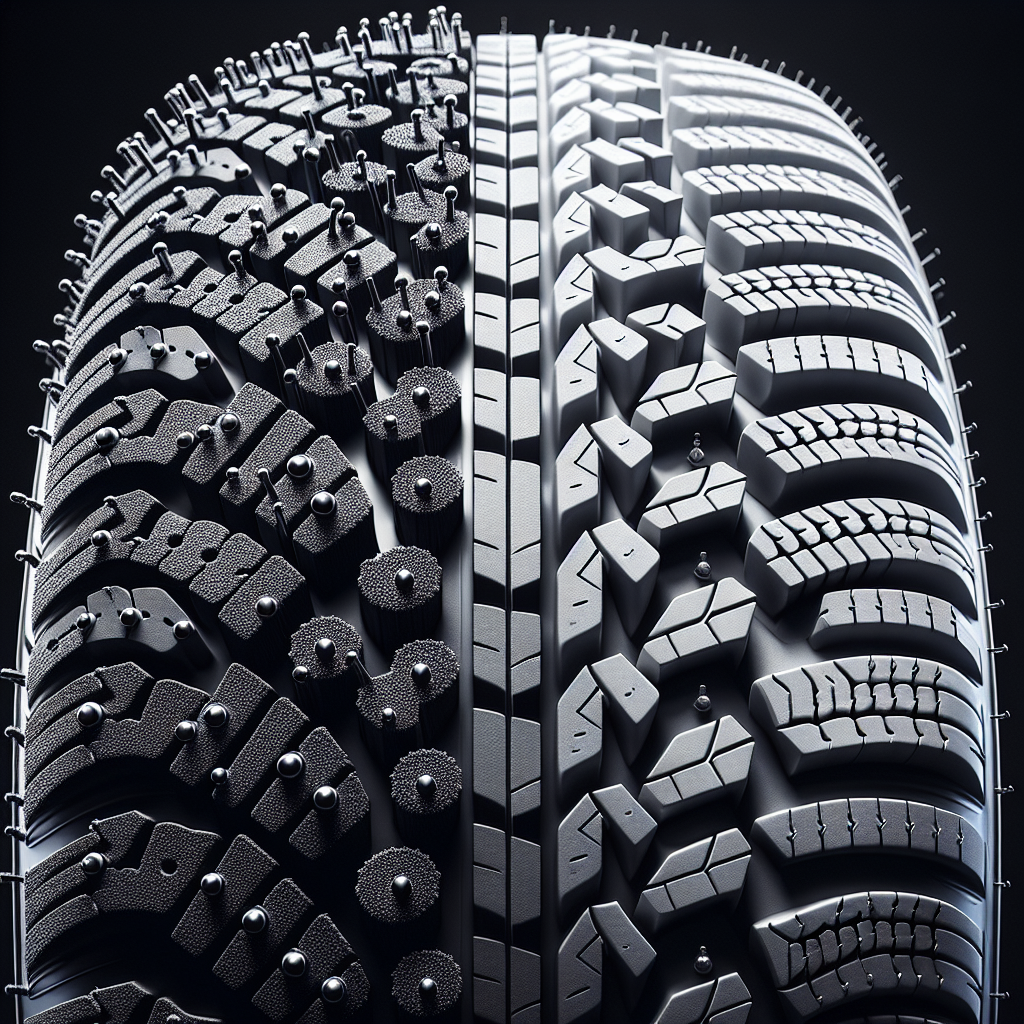In need of new winter tires? Before making a decision, it’s essential to understand the differences between studded and studless winter tires. While both are designed to improve traction and safety on icy roads, they each have their own unique advantages and disadvantages. By gaining insight into these differences, you’ll be better equipped to choose the ideal option for your winter driving needs.

Tire Design
Studded Winter Tires
studded winter tires are specifically designed to provide maximum traction on icy and slippery surfaces. They feature metal studs embedded in the tread, which act as miniature spikes to bite into the ice and improve grip. The studs are typically made of tungsten carbide and covered with a durable material to prevent damage to the road.
Studless Winter Tires
On the other hand, studless winter tires rely on advanced tread designs and innovative rubber compounds to deliver exceptional performance in winter conditions. These tires feature aggressive tread patterns with deep grooves and sipes, which help in channeling snow and slush away from the tire’s surface. The tread compound is engineered to remain flexible, even in extremely cold temperatures, allowing the tire to maintain its grip on slippery surfaces.
Traction
Studded Winter Tires
Studded winter tires excel in providing excellent traction on icy roads. The metal studs effectively dig into the ice, allowing the tire to maintain a strong grip and prevent slipping. These tires offer superior acceleration and braking performance on icy surfaces, making them a popular choice for regions with extreme winter conditions.
Studless Winter Tires
Although studless winter tires lack the metal studs found in their studded counterparts, they still offer impressive traction on snow and ice. The aggressive tread patterns and advanced rubber compounds work together to improve grip and ensure optimal traction in winter conditions. These tires utilize channels and micro-pores to evacuate water and slush, reducing the risk of hydroplaning and maintaining a solid grip on the road.
Ice Performance
Studded Winter Tires
When it comes to ice performance, studded winter tires take the lead. The metal studs effectively penetrate the ice, providing unparalleled traction and stability. They bite into the ice, offering increased control during cornering and braking. Studded tires are particularly beneficial in areas with icy road conditions, where the extra grip can make a significant difference in safety and maneuverability.
Studless Winter Tires
While studless winter tires may not have the added advantage of metal studs, they still deliver commendable performance on ice. The tread patterns and specialized rubber compounds are specifically designed to provide traction and prevent skidding on icy surfaces. Although they may not offer the same level of grip as studded tires, they are a reliable option for areas with occasional ice patches during winter.
Snow Performance
Studded Winter Tires
Studded winter tires also shine in snowy conditions. The metal studs enhance traction on snowy roads, allowing for better acceleration, braking, and cornering. The studs dig into the snow, providing added stability and preventing the tire from sliding. These tires are particularly beneficial in areas with heavy snowfall, where maintaining traction is essential for safe driving.
Studless Winter Tires
Studless winter tires are designed to excel in snow as well. The aggressive tread patterns on these tires prevent snow from packing into the tread, maintaining grip and traction. The specialized rubber compounds ensure flexibility in cold temperatures, enabling the tire to conform to snowy surfaces and provide reliable performance. Studless tires are a great option for areas with moderate snowfall and a mix of winter conditions.

Dry Performance
Studded Winter Tires
In terms of dry performance, studded winter tires can be less efficient than studless tires. The metal studs can reduce the contact area between the tire and the road, limiting grip and handling on dry pavement. Studded tires may feel less responsive during dry conditions, as the metal studs can cause a slight delay in traction. However, modern studded tire designs aim to minimize these drawbacks and provide a decent dry performance.
Studless Winter Tires
Studless winter tires generally offer better dry performance compared to studded tires. The absence of metal studs allows for a larger contact area, resulting in improved grip, handling, and responsiveness on dry roads. The advanced tread designs and rubber compounds of studless tires provide better stability and traction, making them a suitable choice for areas with intermittent winter conditions.
Wet Performance
Studded Winter Tires
When it comes to wet performance, studded winter tires may face some limitations. The metal studs, while effective on ice, can reduce traction on wet surfaces. The studs may struggle to bite into the wet road, potentially leading to reduced grip and longer braking distances. While studded winter tires still offer better wet performance than conventional all-season tires, they may not be as efficient as studless tires in these conditions.
Studless Winter Tires
Studless winter tires shine in wet conditions. The deep grooves and advanced tread designs excellently channel water away from the tire’s surface, reducing the risk of hydroplaning and maintaining constant traction. The softer rubber compounds used in studless tires also enhance their grip on wet roads, providing better braking and handling performance.

Noise
Studded Winter Tires
One aspect where studded winter tires may present a trade-off is noise. As the metal studs contact the road surface, they can produce a distinctive noise, especially when driving on dry pavement. This noise may range from a low hum to a clicking sound, depending on the design and quality of the studs and the road surface. However, advancements in tire technology have significantly reduced the noise generated by studded tire models.
Studless Winter Tires
Compared to studded winter tires, studless winter tires generally offer a quieter driving experience. The tread designs of studless tires are optimized to minimize road noise and vibrations, delivering a smoother and quieter ride. While there may still be some noise associated with the tread patterns, it is significantly less pronounced than the noise generated by studded tires.
Road Damage
Studded Winter Tires
Studded winter tires have long been associated with potential road damage. The metal studs can cause minor abrasions to the road surface, leading to increased wear and tear. However, it’s important to note that advancements in studded tire technology have significantly reduced the potential for road damage. Many studded tire models now feature rounded or cylindrical studs, minimizing the impact on the road.
Studless Winter Tires
In contrast, studless winter tires do not cause any road damage. The absence of metal studs eliminates the risk of abrasive contact with the road surface. Studless tires are designed to be road-friendly, ensuring that they do not contribute to excessive wear or road damage. This makes them a preferred choice for areas concerned about preserving road infrastructure.

Cost
Studded Winter Tires
Studded winter tires generally tend to be more expensive than studless winter tires. The additional cost is attributed to the manufacturing process, which involves embedding metal studs into the tire tread. The studs themselves also add to the overall expense. When considering studded tires, it’s important to factor in both the initial purchase cost and the potential need for stud replacement or removal after winter to comply with legal restrictions.
Studless Winter Tires
Studless winter tires are generally more affordable compared to studded tires. The absence of metal studs reduces the manufacturing and maintenance costs, making studless tires a cost-effective option. While the initial purchase cost may vary based on brand and design, studless tires often provide a better value for money and are more budget-friendly for those looking for reliable winter performance.
Legal Restrictions
Studded Winter Tires
One crucial aspect to consider when choosing studded winter tires is legal restrictions. Some regions have specific regulations regarding the use of studded tires. These regulations often dictate when studded tires are permitted to be used, typically during a specific time frame coinciding with winter weather conditions. Additionally, certain areas may limit the type or number of studs allowed on the tire. It is essential to familiarize yourself with your local laws and restrictions before opting for studded winter tires.
Studless Winter Tires
In contrast, studless winter tires do not face the same legal restrictions as studded tires. Studless tires can be used year-round, providing you the flexibility to keep them on your vehicle without the need for seasonal changes. This can be convenient for areas where winter weather conditions can vary, or if you prioritize ease of use and eliminating the hassle of changing tires.
In conclusion, both studded and studless winter tires offer unique advantages and considerations. Studded tires excel in providing superior traction on ice and in extreme winter conditions, while studless tires deliver excellent performance on snow and are more versatile in mixed winter conditions. Factors such as cost, noise, road damage, legal restrictions, and personal preferences should be taken into account when deciding which type of tire is best suited for your winter driving needs. Remember to prioritize safety and choose the tire that offers the optimal balance between performance, durability, and adherence to local regulations for a worry-free winter driving experience.


